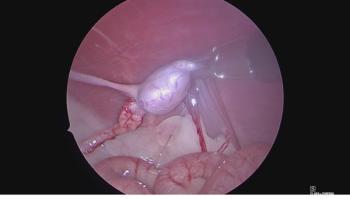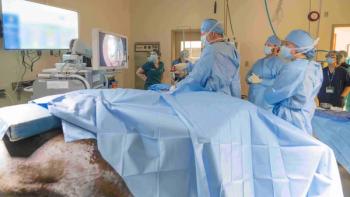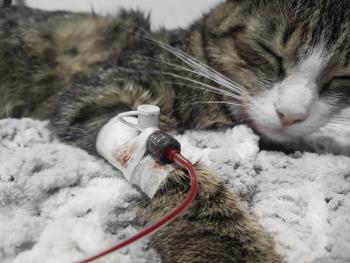
Surgery STAT: Diagnosis and treatment of juvenile canine hip dysplasia
Because hip laxity is the No. 1 risk factor for developing osteoarthritis in the hip joint, it is ideal for all puppies to be evaluated during routine examination. Two methods to assist follow.
EDITOR'S NOTE: SurgerySTAT is a collaborative column between the American College of Veterinary Surgeons (ACVS) and DVM Newsmagazine. This month begins a two-part column by William B. Henry Jr., DVM, Dipl. ACVS. In Part 1 Dr. Henry writes about diagnosing canine hip dysplasia in young dogs. Part 2 in November will further discuss treatment of juvenile canine hip dysplasia, particularly the JPS procedure.
Canine hip dysplasia (CHD) is a heritable polygenic condition compounded with environmental factors that results in laxity of the femoral head ligament. Laxity of the ligament allows hip subluxation. This laxity, along with incongruity of the coxofemoral joint, damages the acetabular labrum and femoral head cartilage, resulting in osteoarthritis (OA) and clinical pain.
Photo 1: Palpation for Ortolani; The puppy is sedated and held in dorsal recumbency. Place your hand on the flexed knee and push the femur straight downward (dorsal) toward the acetabulum. A hip with pathologic laxity will subluxate out of the acetabulum (a). Continue to apply downward (dorsal) pressure on the femur and abduct it towards the table (b). At some point, usually between 20 and 45 degrees of abduction, the hip will relocate into the acetabulum. When this occurs there is a palpable drop as the femoral head seats in the acetabulum, often creating an audible sound (c). The palpable relocation of the femoral head back into the acetabulumm is the Ortolani Sign, confirming pathologic laxity.
At 10 to 20 weeks of age, hip laxity seldom causes clinical signs unless it is severe in very large or overweight, active puppies. Diagnosis in the very young puppy can therefore be difficult.
(b)
Because hip laxity is the No. 1 risk factor for developing OA in the hip joint, it is ideal for all puppies to be evaluated during routine examination. Two methods used to assist in the diagnosis of CHD in puppies are the Ortolani test and PennHip evaluation.
(c)
The Ortolani maneuver described in children can be easily learned and used in sedated puppies 10 to 20 weeks old to determine the presence of pathologic hip laxity (Photo 1: a-c). It is done with the puppy in lateral or dorsal recumbency. The femur is slowly abducted while applying a steady dorsal force to the femur and feeling for subluxation and reduction of the femoral head in the acetabulum. A positive Ortolani confirms hip laxity. A negative test does not rule out hip laxity; it may be a result of insufficient patient relaxation, osteoarthritis or severe abnormality of the coxofemoral anatomy (Photo 2).
Photo 2: VD pelvic radiograph of an 11-week-old Pit Bull cross showing severe dysplasia. This dog did not have an Ortalani because he has "no hip joint." This is shown to emphasize the importance of radiographs as well as palpation when evaluating for hip dysplasia.
PennHip radiographs are a series of three radiographic views (hip extended, distraction and compression views) that allow for assessment of degenerative changes and an objective measurement of hip laxity, reported as the distraction index (Photo 3 a,b). The technique uses the dog's neutral hip angle and a distraction device to yield the distraction index (DI). The DI is a number from 0 to 1 that quantifies the maximum amount the hip luxates out of the acetabulum under passive conditions. PennHIP distraction indices are highly predictive for the risk of development of osteoarthritis in puppies 4 months of age or older. The higher the DI, the greater chance of developing OA in life. This method cannot predict which dogs will have clinical signs of CHD, only the risk of developing OA. Puppies less than 20 weeks old that have a positive Ortolani and/or a PennHip distraction index consistent with hip dysplasia are potential candidates for juvenile pubic symphysiodesis surgery, which will be discussed in Part 2 of this column.
Photo 3: VD and PennHip distraction views of an 18-week-old Golden Retriever puppy. The hip extended VD view looks fairly normal (a); however, the PennHip distraction view confirms laxity (b).
(b)
Dr. William B. Henry, Jr.
Dr. William B. Henry, Jr. is an ACVS board-certified veterinary surgeon and past president of the American College of Veterinary Surgeons (ACVS). He currently practices with Cape Cod Veterinary Specialists and Boston Veterinary Specialists. His primary interest is orthopedic surgery. He is an avid fan of windsurfing, sailing and bicycling.
Visit
Newsletter
From exam room tips to practice management insights, get trusted veterinary news delivered straight to your inbox—subscribe to dvm360.




